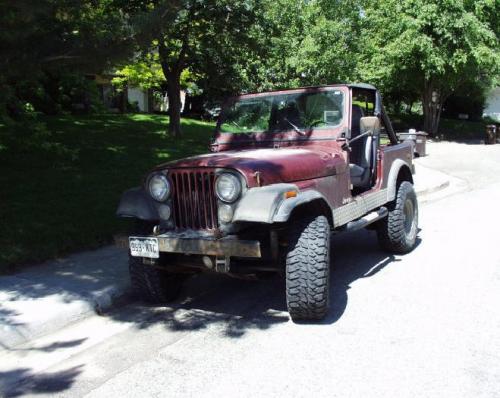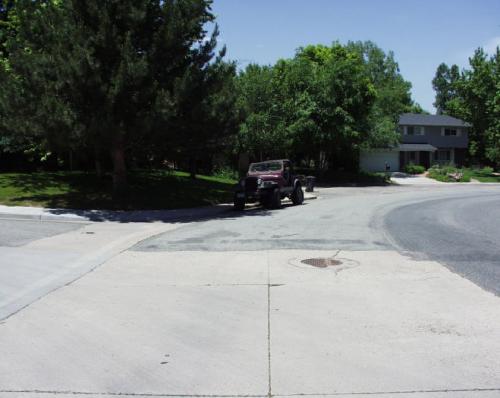How Far Does It Go?
One of the questions we field a LOT is "how far does RF item X go?" And we dutifully hand out the answer as "well, it goes 50, 100, 200 (or whatever) feet." Simple enough, but how far is that? If you're like me, you can't accurately estimate that sort of distance for anything. But we here at SparkFun Electronics are sensitive folk. And just because we love you, our customers (gush!), we decided that it was time to put a face on these numbers.
Ladies and Gentlemen, I give you our target:

Ain't she a beaute? One day she'll have every single SparkFun gadget in her. OK, OK...the gist of the test is that we put a transmitting RF item X on top of the Jeep (on top of the bikini top) and then start walking down the street with a receiving RF item X. We walk until we get about a 50% read rate (as indicated by a blinking LED), read the distance with one of Nate's fancy GPS units and take a picture of the distance in between. This pic is probably about 10 feet away.
Here's the test code if anyone's interested:
The three items we will be testing are theuMiRF, the MiRF and the Laipac TRF-2.4G. The MiRF and the uMiRF use the nRF2401A transceiver chip, the TRF-2.4G uses the nRF2401.
The first of the three contenders is the uMiRF. These guys will go about 60 feet. This wasn't a total surprise for us because the uMiRF was optimized for size first, performance second. What does 60 feet look like?

About like that.
Next up is the MiRF. This one went to 360 feet. 360 feet looks like this:

The Jeep's getting smaller...but wait - there's more!
The last one is the TRF-2.4G from Laipac. That one went .13 miles according to the GPS unit. That's about 686 feet. And what does that look like?

Look at that scenery! I SO love my job! Anyway, my Jeep's still in the middle of the picture, but it's pretty hard to make out.
Along with these pictures, there are a few things you should keep in mind when choosing an RF product from us:
1) Antenna orientation. In these tests I've tried to maximize the distance in every way. The Laipac modules have the antenna lobes pointed at each other, the MiRF's have their monopoles sticking straight up, and the uMiRF's...well, I had them oriented such that the range was greatest and that seemed to be horizontal and turned 90 degrees to each other.
2) Line of sight. At 2.4 GHz, everything becomes an obstacle and a reflector. So to get the best range I've removed as many obstacles and reflectors as I could. As soon as you go inside, it's a whole different ball game.
3) Output power. For the test, all units were configured for 0dBm (1mW). That's the most you can get out of the nRF2401/A.
4) 256Kbps, 16 bit CRC, 8 bit address and 4 byte payload were the remaining configuration items to be aware of. We've found these settings to be pretty reliable. 256K because slow 'n steady wins the race. 4 byte payloads tend to have fewer errors simply because there are fewer bits to be potentially misread.
Hopefully these examples will give everyone an idea of what can be expected from their RF gear under ideal conditions. These are real numbers under real conditions and they're not padded at all (like other manufacturers do). Assuming that all of the Colorado sunshine didn't skew the test, everyone should be able to reproduce these results. Happy Prototyping!
As usual, let us know what you think.
-PDD
June 17th, 2005
if you do a part 2 of this experiment, maybe you can add the wixel too.
I'm very jealous! Hopefully I will land a job in Colorado once I graduate. You guys are so lucky...
I would also love to see an XBee test all the way through the XTend 900MHz models. Then I could build my GPS + RF tracker. They claim 40 miles line-of-sight, but 10 in an urban area would be great.
Wish you would do the same test with the XBee and XBee Pro units... and be sure to post which antenna you used for best distance...just might by about 10 of those!
If you could it would be interesting to repeat the same test, but go through as many houses as you can...
Well it will help with the range drastically...
I guess at such high Frequencies, it would be better to implement a low cost analogue transceiver with a digital interface,Guess when thats goin to come out......
Excellent comparison of the modules!!!!
It is very good for making my decision about which to buy.
This is a REAL test, its the same I will do as soon as they arrive at home.
Thanks